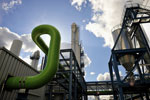Stakeholder event: Carbon Capture and Utilisation Technologies - Technological status, environmental impacts and policy developments
The European Commission’s Directorate-General for Climate Action (DG CLIMA) presented the findings of a recent study on carbon capture and utilisation to interested stakeholders on 17 September 2018.
- carbon dioxide | carbon capture and storage
- Monday 17 September 2018, 15:30 - 19:30 (CEST)
Practical information
- When
- Monday 17 September 2018, 15:30 - 19:30 (CEST)
- Languages
- English
Description

The European Commission’s Directorate-General for Climate Action (DG CLIMA) will present the findings of a recent study on carbon capture and utilisation to interested stakeholders on 17 September 2018.
In 2017, DG CLIMA initiated a study to identify and gain better understanding of innovative and promising carbon capture and utilisation (CCU) technologies.
The study, conducted by Ramboll together with consortium partners Institute for Advanced Sustainability Studies (IASS Potsdam), Universität Kassel, Center for Environmental Systems Research, CE Delft and IOM Law, had two specific objectives:
1. Assess the technological and market readiness of different CCU technologies and clarify which types of technologies are viable for support, including from the planned Innovation Fund under the EU ETS.
2. Examine the EU regulatory setup related to CCU technologies, and assess whether specific provisions are necessary to enhance the contribution of these innovative technologies to climate mitigation.
The public event will present the findings of this study, as well as the recently adopted scientific opinion on CCU. Leading academic, industry and policy experts in the field will conduct a panel discussion on key issues such as current and future potential for CCU technologies in the EU, industry and research efforts, policy implications, links to EU climate objectives, energy issues and impacts on other technologies such as electrification, hydrogen, and renewables.
Agenda
Event summary
A number of novel carbon capture and utilisation (CCU) technologies are under development for the production of low-carbon fuels, chemicals and building materials. They use CO2 as a feedstock rather than letting it out in the atmosphere, thus potentially contributing to the circular economy, climate mitigation and the global competitiveness of European industry.
Most of these technologies are not yet commercialised. Therefore, there is a lot of uncertainty about their economic and environmental impacts. Many researchers and industries are working hard to further develop these technologies and provide clearer answers on the possible contribution of these technologies to the EU’s policy objectives.
On 17 September 2018, the European Commission’s Directorate-General for Climate Action organised a stakeholder event to present two major works on these technologies:
- the study “Identification and analysis of promising Carbon Capture and Utilisation technologies, including their regulatory aspects”, conducted by Ramboll, together with the Institute for Advanced Sustainability Studies (IASS Potsdam), Kassel University, Center for Environmental Systems Research (CESR), CE Delft and IOM Law.
- the scientific opinion of the Group of Chief Scientific Advisors of the European Commission underpinned by an evidence review report produced by SAPEA - a consortium of academies of science.
The panel discussion highlighted some of the findings of the studies and industry representatives, researchers, policy makers and NGOs brought additional elements from their experience. Some of the key points raised were:
- By 2050 we need solutions that will either circulate the carbon or remove it from the atmosphere at competitive costs. CCU technologies are one piece of the puzzle especially for industries that have hard to abate emissions or for industries that will need carbon as a feedstock.
- Cross-sectoral innovation will be very important where the waste of one industry can become the feedstock of another.
- Some mineralisation routes provide the opportunity to solve two problems at the same time: waste ashes and slags from industry can be converted with CO2 to useful products like building materials instead of being landfilled.
- In the long-term, CCU fuels will have a potential to replace fossil fuels in sectors, where alternatives may be limited such as fuels for aviation.
- CCU technologies will need to overcome still a number of challenges related to conversion efficiencies, costs, developing of markets and persuading customers.
- Large-scale expansion of CCU technologies will require large volumes of renewable energy and hydrogen at competitive prices, which are in itself decarbonisation pathways. These developments will need to go hand in hand in order to reap the environmental and economic promise of CCU technologies where these will be relevant solutions.
- We must make sure that these technologies are further developed in the EU and become available for the relevant CCU applications in the mid-term. Otherwise, we reduce our options for the future, possibly leading to considerable costs and inefficient solutions.
- We have the financial support framework – the future Horizon Europe and Innovation Fund – to support the technological development and proving of concepts and impacts.
- Whereas, the main benefit of these technologies will be for the circular economy, we need to further develop our regulatory framework to acknowledge when there is contribution from these technologies to our climate objectives. A harmonised life-cycle assessment (LCA) is a first and indispensable step. The revised Renewables Directive is already giving the impetus for fuels. We need to start rethinking our emissions monitoring framework for the period after 2030. We should also look at the possibilities that public procurement and state-aid rules offer to support innovative technologies that are beneficial for the climate.
Presentations
- Introduction
- Technological assessment (Part 1), Study “Identification and analysis of novel and promising CCU technologies”
- Technological assessment (Part 2), Study “Identification and analysis of novel and promising CCU technologies”
- Regulatory assessment, Study “Identification and analysis of novel and promising CCU technologies”
- Opinion of the Scientific Advice Mechanism (SAM) on novel CCU technologies
- Science Advice for Policy by European Academies (SAPEA) Evidence Review report on CCU technologies
Location
Centre Albert Borschette, rue Froissart 36, 1049 Brussels
